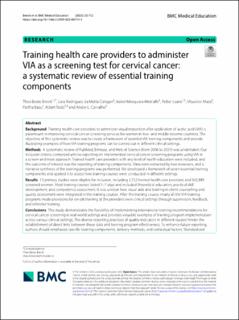| dc.contributor.author | Brevik, Thea Beate | |
| dc.contributor.author | da Matta Calegari, Lara Rodrigues | |
| dc.contributor.author | Metcalfe, Isabel Mosquera | |
| dc.contributor.author | Laake, Petter | |
| dc.contributor.author | Maza, Mauricio | |
| dc.contributor.author | Basu, Partha | |
| dc.contributor.author | Todd, Adam | |
| dc.contributor.author | Carvalho, Andre L. | |
| dc.date.accessioned | 2024-01-15T17:12:28Z | |
| dc.date.available | 2024-01-15T17:12:28Z | |
| dc.date.created | 2023-10-20T09:11:34Z | |
| dc.date.issued | 2023 | |
| dc.identifier.citation | BMC Medical Education. 2023, 23 (1) | en_US |
| dc.identifier.issn | 1472-6920 | |
| dc.identifier.uri | https://hdl.handle.net/11250/3111616 | |
| dc.description.abstract | Background
Training health care providers to administer visual inspection after application of acetic acid (VIA) is paramount in improving cervical cancer screening services for women in low- and middle-income countries. The objective of this systematic review was to create a framework of essential VIA training components and provide illustrating examples of how VIA training programs can be carried out in different clinical settings.
Methods
A systematic review of PubMed, Embase, and Web of Science (from 2006 to 2021) was undertaken. Our inclusion criteria comprised articles reporting on implemented cervical cancer screening programs using VIA in a screen-and-treat approach. Trained health care providers with any level of health education were included, and the outcome of interest was the reporting of training components. Data were extracted by two reviewers, and a narrative synthesis of the training programs was performed. We developed a framework of seven essential training components and applied it to assess how training courses were conducted in different settings.
Results
13 primary studies were eligible for inclusion, including 2,722 trained health care providers and 342,889 screened women. Most training courses lasted 5–7 days and included theoretical education, practical skill development, and competence assessment. It was unclear how visual aids and training in client counselling and quality assessment were integrated in the training courses. After the training course, nearly all the VIA training programs made provisions for on-job training at the providers’ own clinical settings through supervision, feedback, and refresher training.
Conclusions
This study demonstrates the feasibility of implementing international training recommendations for cervical cancer screening in real-world settings and provides valuable examples of training program implementation across various clinical settings. The diverse reporting practices of quality indicators in different studies hinder the establishment of direct links between these data and training program effectiveness. To enhance future reporting, authors should emphasize specific training components, delivery methods, and contextual factors. Standardized reporting of quality indicators for effective evaluation of VIA training programs is recommended, fostering comparability, facilitating research, and enhancing reporting quality in this field. | en_US |
| dc.language.iso | eng | en_US |
| dc.publisher | BioMed Central Ltd. | en_US |
| dc.rights | Navngivelse 4.0 Internasjonal | * |
| dc.rights.uri | http://creativecommons.org/licenses/by/4.0/deed.no | * |
| dc.title | Training health care providers to administer VIA as a screening test for cervical cancer: a systematic review of essential training components | en_US |
| dc.title.alternative | Training health care providers to administer VIA as a screening test for cervical cancer: a systematic review of essential training components | en_US |
| dc.type | Peer reviewed | en_US |
| dc.type | Journal article | en_US |
| dc.description.version | publishedVersion | en_US |
| dc.source.volume | 23 | en_US |
| dc.source.journal | BMC Medical Education | en_US |
| dc.identifier.doi | 10.1186/s12909-023-04711-5 | |
| dc.identifier.cristin | 2186597 | |
| dc.source.articlenumber | 712 | en_US |
| cristin.ispublished | true | |
| cristin.fulltext | original | |
| cristin.qualitycode | 1 | |

